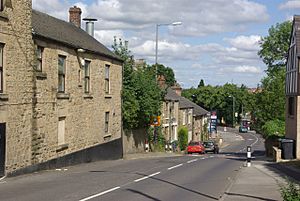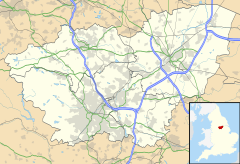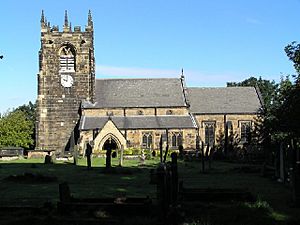Beighton, South Yorkshire facts for kids
Quick facts for kids Beighton |
|
|---|---|
 High Street, Beighton |
|
| OS grid reference | SK408838 |
| Metropolitan borough | |
| Metropolitan county | |
| Region | |
| Country | England |
| Sovereign state | United Kingdom |
| Post town | SHEFFIELD |
| Postcode district | S20 |
| Police | South Yorkshire |
| Fire | South Yorkshire |
| Ambulance | Yorkshire |
| EU Parliament | Yorkshire and the Humber |
| UK Parliament |
|
Beighton is a historic village located about 6 miles southeast of Sheffield city centre. It became part of Sheffield in 1967, moving from Derbyshire to the new county of South Yorkshire, England. For a long time, from the late 1600s to the 1800s, Beighton was known for making tools, especially sickles, in nearby Hackenthorpe.
Today, Beighton has several schools, like Beighton Nursery and Infant School. Even with new houses, Beighton still feels like a countryside village because it's on the edge of Sheffield, close to places like Eckington and Mosborough.
Contents
Beighton's Ancient Past
The first records of Beighton come from the 800s, in Anglo Saxon documents about land in Derbyshire. Back then, it was called Bectune. This small settlement was on the edge of a huge forest. This 'Great Forest' once covered the area where Rother Valley Country Park is now, and stretched into other counties. Today, the only part left is Sherwood Forest.
Early Settlers and Borders
The area was settled by a group of people called the Angles. They arrived around 500 AD, after the Roman period ended. Before the Angles, this land was part of the Kingdom of Mercia. A local stream, called Shire Brook, formed the border with the nearby kingdom of Northumbria. Being so close to a border meant the village often faced invasions.
Stone Age Discoveries
The Sheffield Museum has bones and flint tools found in Beighton during the 1800s. These items date back to the Neolithic period (New Stone Age). This shows that people lived in this area long before the Angles settled here.
Beighton in the Domesday Book
In 1086, the Domesday Book mentioned Beighton as having 15 households. The land was owned by Roger the Poitevin. People believed there was once a moated castle in the village. A record from the 1200s even spoke of 'the tower of the former castle' in a field called Castle Mead. However, no signs of this castle remain today.
St. Mary's Church History
The parish church of St. Mary's was built around 1150. The first written mention of the church is in a document from the time of King Edward I (1272–1307).
Changing Jobs in Beighton
Before the 1900s, most people in Beighton worked in farming or as smiths. But by the late 1800s, many started working in mining. Several mines opened nearby, including Brookhouse Colliery and Birley Collieries. The Ochre Dyke stream helped power grinding and water wheels during this time.
Transport and Floods
Beighton used to have its own train station, Beighton railway station, which closed in 1954. Because Beighton is close to the River Rother, it has experienced several big floods. Notable floods happened in 1940, 1954, and 1960.
Beighton Today
Beighton, along with other local villages, officially became part of Sheffield city in 1967. It is now recognized as the Beighton (ward) area. The Crystal Peaks shopping centre opened in 1988, offering regular bus routes to Sheffield city centre. Many people living in Beighton now work in Sheffield or other nearby cities like Worksop.
Fun and Recreation
Rother Valley Country Park opened in 1983. It's a great place for outdoor activities. Gulliver's Valley, a theme park, also opened north of the village in 2020, offering more fun for families.
Local Gathering Spots
Beighton once had many public houses (pubs), like The Railway Inn. Today, only The Cumberland, Fox Inn, and the Miners Welfare remain as local gathering spots.
Beighton's Sporting Spirit
Beighton has a strong history in sports. The Beighton Miners Welfare F.C. football team even reached the First Round of the FA Cup in 1953. Cricket is also very popular in the village. The Miners' Welfare Cricket Club was formed in 1928 after joining with the nearby Hackenthorpe Cricket Club.



